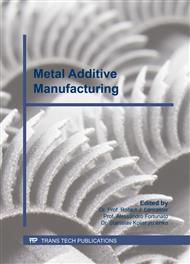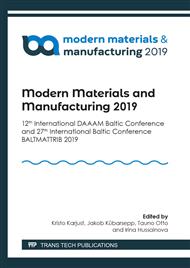[1]
W.K. Chiu, Y.C. Yeung, K.M. Yu, Toolpath generation for layer manufacturing of fractal objects, Rapid Prototyping J. 12 (2006) 214-221.
DOI: 10.1108/13552540610682723
Google Scholar
[2]
G.E. Geen, S.J. Hollister, Bioresorbable Airway Splint Created with a Three-Dimensional Printer, New Engl. J. Med. 368 (2013) 2043-2045.
DOI: 10.1056/nejmc1206319
Google Scholar
[3]
Information on http://www.nasa.gov/content/open-for-business-3-d-printer-creates-first-object-in-space-on-international-space-station/#.VHbjLTGUdK2.
Google Scholar
[4]
T.R. Jackson, H. Liu, N.M. Patricalakis, E.M. Sachs, M.J. Cima, Modeling and Designing Graded Material Components for Fabrication with Local Composition Control, Mater. Design 20 (1999) 63-75.
DOI: 10.1016/s0261-3069(99)00011-4
Google Scholar
[5]
A. Noriega, D. Blanco, B.J. Alvarez, A. Garcia, Dimensional accuracy improvement of FDM square cross-section parts using artificial neural networks and an optimization algorithm, The Int. J. Adv. Manuf. Tech. 69 (2013) 2301-2313.
DOI: 10.1007/s00170-013-5196-2
Google Scholar
[6]
E. Pei, 4D Printing: dawn of an emerging technology cycle, Assembly Autom. 34 (2014) 310-314.
DOI: 10.1108/aa-07-2014-062
Google Scholar
[7]
P. Muller, J.-Y. Hascoet, P. Mognol, Toolpath for additive manufacturing of functionally graded materials (FGM) parts, Rapid Prototyping J. 20 (2014) 511-522.
DOI: 10.1108/rpj-01-2013-0011
Google Scholar
[8]
V. Gupta, K.S. Kasana, P. Tandon, A Computer Aided Design Modeling for Heterogeneous Objects, Int. J. Comput. Sc. Issues. 7 (2010) 31-38.
Google Scholar
[9]
I. Shishkovsky, Synthesis of functional gradient parts via RP methods, Rapid Prototyping J. 7 (2001) 207-211.
DOI: 10.1108/13552540110402908
Google Scholar
[10]
Information on http://www.materialecology.com/assets/pdf/Publications_FGRP.pdf.
Google Scholar
[11]
A.K.M.B. Khoda, B. Koc, Functionally heterogeneous porous scaffold design for tissue engineering, Computer-Aided Design. 45 (2013) 1276-1293.
DOI: 10.1016/j.cad.2013.05.005
Google Scholar
[12]
J.D. Royo, L.M. Soldevila, N. Oxman, Flow-based fabrication: Anintegraded computational workflow for design and digital additive manufacturing of multifunctional heterogeneous structured objects, Comput. Aided Design 69 (2015) 143-154.
DOI: 10.1016/j.cad.2015.05.005
Google Scholar
[13]
Information on web.mit.edu/2.810/www/files/readings/AdditiveManufacturingTerminology.pdf.
Google Scholar
[14]
X.Y. Kou, S.T. Tan, Heterogeneous object modeling: a review, Comput. Aided Design 39 (2007) 284-301.
DOI: 10.1016/j.cad.2006.12.007
Google Scholar
[15]
J. Hiller, H. Lipson, Design and analysis of digital materials for physical 3D voxel printing, Rapid Prototyping J. 15 (2009) 137-149.
DOI: 10.1108/13552540910943441
Google Scholar
[16]
J. Hiller, H. Lipson, Tunable digital material properties for 3D voxel printers, Rapid Prototyping J. 16 (2010) 241-247.
DOI: 10.1108/13552541011049252
Google Scholar
[17]
J. Yuan, H. Yong, F. Guoqiang, Z. Aibing, D. Jianke, A non-retraction path planning approach for extrusion-based additive manufacturing, Robot. Cim.-Int. Manuf. 48 (2017) 132-144.
Google Scholar



